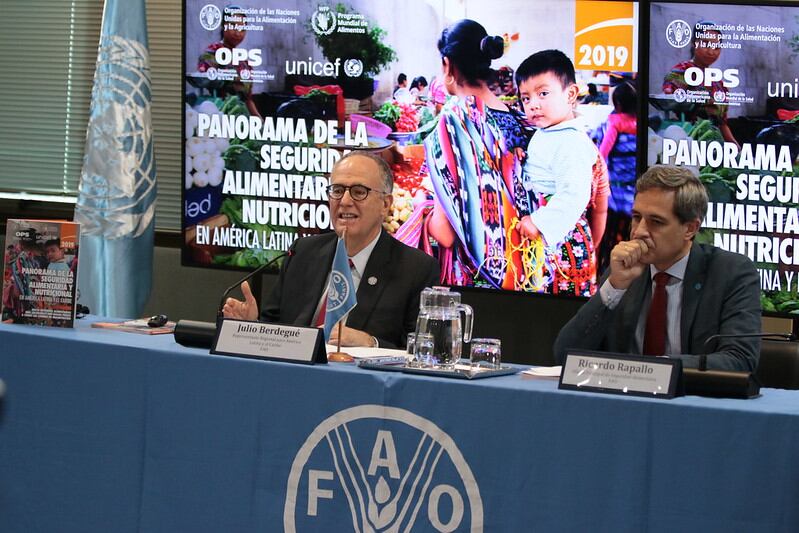In its latest report, the UN calls for a closer look at the economic, political and societal landscape in Latin America and the Caribbean to undercover immediate and longer-term initiatives that can restrict the rising levels of obesity and hunger.
Together, the FAO, the Pan American Health Organization/World Health Organization (PAHO/WHO), the United Nations Children's Fund (UNICEF) and the World Food Program (WFP) are striving to significantly curb the rise of both obesity and hunger in LATAM.
600,000 deaths due to unhealthy food
Every year, 600,000 people in Latin America and the Caribbean die as a result of diet-related diseases, such as diabetes, hypertension and cardiovascular diseases, the report relays. Low intakes of whole grains, nuts, seeds and vegetables, as well as high sodium diets, are the most common food risk factors.
As the true impact is felt, global organizations are now striving to reduce the continued health risk for future generations by addressing the rates of obesity.
The obesity epidemic in Latin America and the Caribbean is at crisis level, with 24% of the regional population obese — a figure that is almost double the worldwide rate of 13.2%.
Describing this rise as an “explosive increase in obesity”, the Food and Agriculture Organization (FAO)’s Regional Representative, Julio Berdegué emphasizes that not only does it have “huge economic costs, but [it] also threatens the lives of hundreds of thousands”.
Ultra-processed food products, is the fastest growing trend in food in LATAM, reducing consumers’ exposure to products rich in nutrition, and instead, increasing access to excessive amounts of sugar, sodium and fat. Consumption levels of ultra-processed products rose by over 25%, while fast food consumption also grew by nearly 40% between 2000 and 2013.
“We must act now to reverse this trend and prevent children from suffering the consequences of poor diets on their health and their future quality of life,” advises Carissa F. Etienne, Director, PAHO/WHO.
“To achieve this, we need the commitment of the whole society and public policies that regulate unhealthy food products, create environments conducive to physical activity and promote healthy eating at school and at the family table.”
Reverse rising rates
Latin America and the Caribbean experience the worst global malnutrition figures. Since the 1970s, the number of overweight people has doubled to 59.5% of adults, while the global overweight rate is 39.1%.
However, the LATAM region has worked hard to successfully lower malnutrition. Undernourishment rates stand at 6.5% compared to the global level of 10.8%, stunting in the region is at 9% compared to 21.9% around the globe, and wasting has dropped to 1.3% compared to 7.3% worldwide.
Despite these efforts, hunger remains at the forefront of the agencies' efforts, as its prevalence has grown by 4.5 million people since 2014, representing an 11% increase. Hunger has now reached its highest levels in the last ten years, amounting to 42.5 million people.
Proposing change
Countries need to encourage healthier food environments to promote nutritious foods. To initiate and implement successfully, an overhaul of how healthy food is produced, distributed and sold is required. As such, a review of governmental decisions, education and marketing practices and processes can deliver recommendations for change.
The UN proposes the introduction of taxes and incentives that favor healthy food, social protection systems, school feeding programs and the regulation of food advertising and marketing.
Leading organizations also prioritize the need for clear food labeling that contains front-of-the-pack nutritional warning systems. Currently, several Latin American nations are proposing changes to how they display nutritional information on their food and beverage products, with responses to public consultations and outcomes expected in 2020.
Initiatives that explain and communicate the quality and safety of foods sold are also key areas that the agencies plan to tackle. In instances where food and beverages do not contain nutritionally adequate content, the agencies will address the importance of reformulating compositions to maximize nutritional benefits.
Changing food landscapes
Understanding changes in the way people obtain, prepare and consume food is vital to reverse the impact of non-nutritious food and beverage proliferation.
“In Latin America and the Caribbean, too many children eat too little healthy food and too much processed food,” said Bernt Aasen, UNICEF Regional Director (a.i.) for Latin America and the Caribbean.
There has been a rapid rise in income, developing urbanization, improvements to infrastructure, liberalization of market regulation policies and the increase of rural non-agricultural employment, the WHO reveals. As a result, these have compounded to transform LATAM’s food system and consequently, food consumption patterns.
Prepared food and out-of-home meals have become sought after as convenient options for on-the-go consumers. An imbalance between the amount of cultivated land dedicated to the production of basic inputs for processed and ultra-processed products such as oils, flours and sugar has occurred alongside a reduction in production areas for fruits, vegetables and legumes.
Supermarket chains, fast food stores and sizable food processing industries have catapulted in recent years. The rise in technological innovations has led to an increase in manufacturers’ production capabilities and the accessibility of ultra-processed foodstuffs. Accompanying price points are also lower than their nutritious alternatives, offering a simpler and more affordable option for families.
Healthier food environments
Countries have responded to the malnutrition crisis by creating a series of public policies. Chile, Ecuador, Peru and Uruguay have brought food labeling laws into force that provide clarity to empower and enable consumers to make healthier decisions by selecting nutritious foods.
Food advertising has also come under scrutiny, with Brazil, Chile, Costa Rica, Ecuador, Mexico, Peru, Panama and Uruguay, making progressive modifications to their regulations. At least 13 countries in LATAM have also implemented fiscal and social measures that aim to promote nutritious food.
"If we expand social protection programs in our region, we would better face the double burden that hunger and obesity represent for communities and families," said Miguel Barreto, Regional Director, WFP. "These are the two faces of malnutrition."

